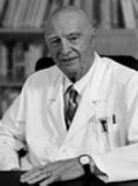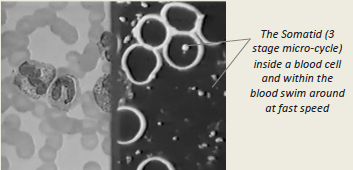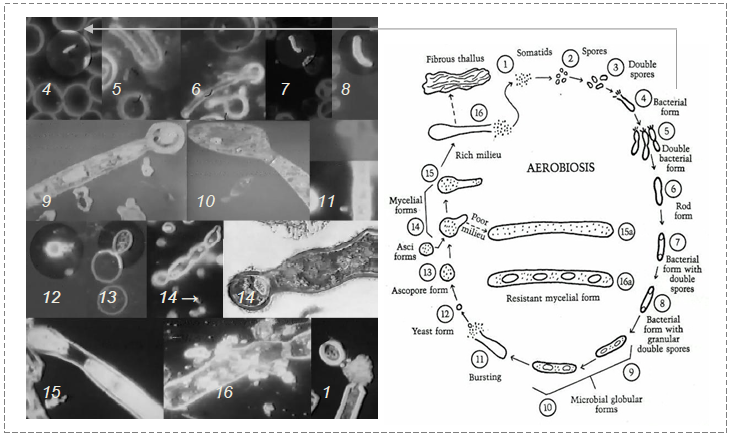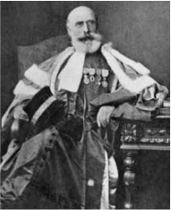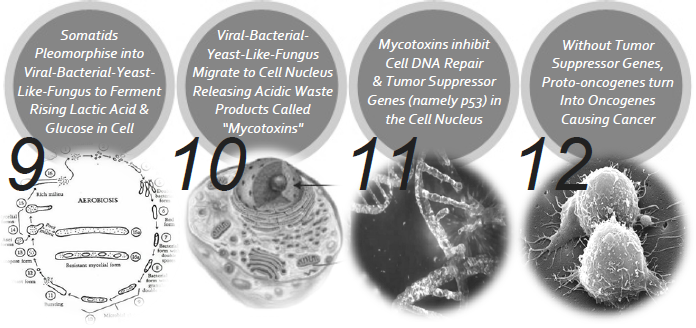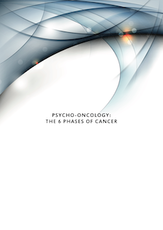Psycho-Oncology: Discover How Stress Causes Cancer
Phase 1 of Cancer: Inescapable Shock
Phase 2 of Cancer: Adrenaline Depletion
Phase 3 of Cancer: The Cancer Fungus
Phase 4 of Cancer: Niacin Deficiency
Phase 5 of Cancer: Vitamin C Depletion
Phase 6 of Cancer: Immune Suppression
PHASE 3 OF CANCER: THE CANCER FUNGUS
During phase 3, somatids (tiny microorganisms necessary for life) that live in our body pleomorphise [or change] into yeast-like-fungus to ferment excess glucose and lactic acid in cells. In a healthy person, somatids are limited to 3 stages in their life cycle – somatid, spore, double spore. However, in a highly acidic (low pH) lactic acid environment caused by prolonged chronic stress breaking the cell's Krebs' Citric Acid Cycle, somatids pleomorphise into a further 13 stages. These stages include viral-bacterial-yeast-like-fungus forms which then migrate to the cell nucleus to reproduce, releasing acidic waste products called “mycotoxins”, inhibiting cell DNA repair and inhibiting the all-important tumor suppressor genes. Without the tumor suppressor genes [namely p53] to regulate cell death (apoptosis) when the cell has mutated beyond repair, the cell lives on and ‘cell-growth regulating’ proto-oncogenes turn into oncogenes, causing normal cells to mutate into cancer cells.
THE THEORY: BY GLEN RUSSELL,
PUNA WAI ORA MIND-BODY CANCER CLINIC
Over the past few centuries leading microbiologists from all over the world have discovered a tiny microorganism necessary for life that underpins all life, including all stem cell and viral-bacterial growth. This tiny microorganism has been given many names including the Somatid, the Microzyma, the Bione, the Sanal/P-Microcell/Granule, the Protit and the Turquoise Blue Granule. These "somatids" are so small they appear invisible under normal microscopic lens, and require high magnification equipment to see their naturally active moving state. A common feature of these somatid life forms, observed uniformly, is their ability to pleomorphise (change) into viral-bacterial-yeast-like-fungus forms under low pH acidic conditions. Microbiologists who have identified these somatid life forms include Antoine Béchamp [Professor of Chemistry at the University of Strasbourg]; Arthur Isaac Kendall PhD [Director of Medical Research, Northwestern University Medical School Chicago]; Royal Raymond Rife PhD [inventor of the high-magnification Rife Microscope]; Edward C Rosenow, Sr [who served as Director of Experimental Biology for the Mayo Clinic between 1915 and 1944]; Bong-Han Kim [medical surgeon at Pyongyang Medical University and Kyung-Rak Institute who is widely recognized to have discovered the primo-vascular system]; Kwang-Sup Soh [professor at the Biomedical Physics Laboratory, School of Physics, Seoul National University, South Korea]; Wilhelm Reich [Deputy Director of the Vienna Ambulatorium, Sigmund Freud's psychoanalytic outpatient clinic]; and Professor Gunther [zoologist], amongst many others. The most recent of these academics to discover the existence of this living organism is Professor Gaston Naessens of France who coined the term "somatid" to describe these small bodies. Professor Naessens found when cell tissue is healthy, [these somatids that live in the tissue and blood as well as the intracellular cytosol of the cell] are limited to 3 stages - somatid, spore, and double spore; however when the cell environment is acidic and the immune system impaired, these tiny microorganisms pleomorphise into a further 13 viral-bacterial-yeast-like-fungus stages to ferment excess glucose and lactic acid, causing cancer. These fungal pathogenic forms migrate to the cell nucleus to reproduce, releasing acidic waste products called "mycotoxins", inhibiting cell DNA repair and inhibiting the all-important tumor suppressor genes. Without tumor suppressor genes [namely p53] to regulate cell death (apoptosis) when the cell has mutated beyond repair, the cell lives on and 'cell-growth-regulating' proto-oncogenes turn into oncogenes, causing normal cells to mutate into cancer cells. While Professor Naessens observed these viral-bacterial-yeast-like-fungus forms were the cause of cancer within the body, he is not however the first to have observed the connection between cancer and these microbes.
In 1890 William Russell [pathologist in the School of Medicine at the Royal Infirmary in Edinburgh] found parasitic yeast-like fungus organisms within all forms of cancer he examined, which ranged from barely visible to "half again as large as a red blood corpuscle". In 1901, Harvey Gaylord of New York State Pathological Laboratory of the University of Buffalo confirmed Russell's research, finding small to large parasitic forms in every cancer he examined and published a report in the American Journal of the Medical Sciences titled "The Protozoon of Cancer". In the 1920s, James Young [an obstetrician from Scotland] was able to grow pleomorphic viral-bacterial stages from various cancers which he found had a specific life cycle and spore stages. In 1925, John Nuzum [pathologist and physician at the University of Illinois, College of Medicine] isolated pleomorphic virus-like bacteria from 38 of 41 early stage breast cancers and was able to induce breast cancer in 2 or 5 dogs injected with these microbes. In 1932, Royal Raymond Rife [granted an honorary Doctor of Parasitology by the University of Heidelberg Germany for his work in making all the photo-micrographs for the "Atlas of Parasites"] cultured a viral-bacterial microorganism from a human breast cancer which he injected into 412 healthy rats which all developed breast cancer without fail. He subsequently found this microbe morphed into various viral-bacterial-yeast-like-fungus forms. In the 1940-1950s, Virginia Livingston [first female resident physician at a New York hospital, assigned to study bacterial infection], microbiologist Eleanor Alexander Jackson PhD [awarded the A. Cressy Morrison Prize by the New York Academy of Sciences for discovering certain forms of tubercle bacteria] and Irene Diller of the National Cancer Institute Fox Chase Cancer Center, Philadelphia collaborated together after each independently observing the microbe in cancer. After culturing the viral-bacterial microbe from human breast cancer tissue and re-injecting it into mice, they found the incidence of cancer doubled. Since then mainstream medicine has discovered the human papilloma virus (HPV) to be the cause of cervical cancer and head, neck and throat cancer; helicobacter pylori c. bacteria to be the cause of stomach cancer; hepatitis B and C virus to be the cause of liver cancer; and schistosoma haematobium (bilharziasis) bacteria to cause bladder cancer.
In 1890 William Russell [pathologist in the School of Medicine at the Royal Infirmary in Edinburgh] found parasitic yeast-like fungus organisms within all forms of cancer he examined, which ranged from barely visible to "half again as large as a red blood corpuscle". In 1901, Harvey Gaylord of New York State Pathological Laboratory of the University of Buffalo confirmed Russell's research, finding small to large parasitic forms in every cancer he examined and published a report in the American Journal of the Medical Sciences titled "The Protozoon of Cancer". In the 1920s, James Young [an obstetrician from Scotland] was able to grow pleomorphic viral-bacterial stages from various cancers which he found had a specific life cycle and spore stages. In 1925, John Nuzum [pathologist and physician at the University of Illinois, College of Medicine] isolated pleomorphic virus-like bacteria from 38 of 41 early stage breast cancers and was able to induce breast cancer in 2 or 5 dogs injected with these microbes. In 1932, Royal Raymond Rife [granted an honorary Doctor of Parasitology by the University of Heidelberg Germany for his work in making all the photo-micrographs for the "Atlas of Parasites"] cultured a viral-bacterial microorganism from a human breast cancer which he injected into 412 healthy rats which all developed breast cancer without fail. He subsequently found this microbe morphed into various viral-bacterial-yeast-like-fungus forms. In the 1940-1950s, Virginia Livingston [first female resident physician at a New York hospital, assigned to study bacterial infection], microbiologist Eleanor Alexander Jackson PhD [awarded the A. Cressy Morrison Prize by the New York Academy of Sciences for discovering certain forms of tubercle bacteria] and Irene Diller of the National Cancer Institute Fox Chase Cancer Center, Philadelphia collaborated together after each independently observing the microbe in cancer. After culturing the viral-bacterial microbe from human breast cancer tissue and re-injecting it into mice, they found the incidence of cancer doubled. Since then mainstream medicine has discovered the human papilloma virus (HPV) to be the cause of cervical cancer and head, neck and throat cancer; helicobacter pylori c. bacteria to be the cause of stomach cancer; hepatitis B and C virus to be the cause of liver cancer; and schistosoma haematobium (bilharziasis) bacteria to cause bladder cancer.
Professor Gaston Naessens: “A somatid is a basic living particle. It is indispensable for life. Without it, cellular division can’t take place. It is polymorphic [meaning it can grow from one form to another, from a virus to a bacterium to a fungus]. We were able to grow it in a culture and that’s where we observed its polymorphism in two cycles. First there is a micro-cycle during which the reproductive hormone that permits cellular division is developed. This [healthy 3 stage] cycle is stopped by inhibitors in the blood and during certain illnesses, including degenerative diseases. This micro-cycle, in 3 stages keeps going and becomes a 16 stage cycle [during illness]. In 1949 when I was working in haematology I had the feeling I wasn’t seeing everything there was to see in blood. I saw something moving, but I didn’t know what it was. I concentrated on the problem of light wave-lengths. That’s how I perfected a system that gave me very worthwhile results and which enabled me to develop a microscope that allows us to see this famous particle. Little by little I was able to observe it and I extracted it from the blood. I was able to isolate it and grow it in a culture and that’s how I established its polymorphism."
Professor Gaston Naessens continued: "For more than a century the traditional method of examining blood has consisted of smearing it onto a slide, fixing it and staining it, to determine the tinctorial affinities (properties) of the elements it contains. On the left [above] we can see blood prepared according to this method. We can identify the red corpuscles, white corpuscles and platelets. This is dead blood. On the right we are seeing blood through a somatoscope. This is living blood examined within 10 minutes after it was drawn. We can see red corpuscles, white corpuscles, platelets and somatids, which we couldn't see on the fixed slide. In the course of this [somatid] micro-cycle, a growth hormone is formed that is indispensable for cellular division. This phenomenon has been observed repeatedly in in-vitro cultures. If under the effects of stress or for that matter any biological stressor the blood's [immune] inhibitors are diminished to any considerable degree, the somatids' micro-cycle evolves into a cycle that is both different and polymorphic. We then see the appearance of the various stages of a macro-cycle - 13 additional stages in all [seen in the diagram below]. First we notice a bacterial form that is the normal evolution of the micro-cycle [in stage 4] where the inhibitors have been diminished. This endogenous bacterial form has been observed by many researchers. The double bacteria which evolves [in stage 5] from the preceding bacterial form is often observed in blood smears. Its particularity is the ability to divide itself by scissiparity to form rods. The rod form [stage 6] looks like a bacterial form expect that it is longer and its cytoplasm seems empty. It should be noted this [next] bacterial form [in stage 7] possesses two terminal spores. The granulated double-spore bacterial form [seen in stage 8] has a cytoplasm filled with granulations that begin to move. The maturation of the granulated double-spore bacterial form [in stage 9] results in a mycobacteria well-known to microbiologists. The cytoplasm is also self-developing. The myco-bacteria that we have just seen [in stage 10] has developed further and formed bubble-like enclaves to which it owes its name: bubble-mycobacteria. Here we see the bursting of the bubble-mycobacteria [in stage 11] and the release of its elements of its cytoplasm into the medium. The yeast-like formations that result [in stage 12] from the bursting of the bubble-mycobacteria, have a diameter of 4-5 microns. The yeast-like formations proliferate and become ascospore forms [in stage 13], pre-cursors of mycelial elements. From an asci form we can observe the formation of a phallus [in stage 14] in which the cytoplasm gradually takes shape to constitute the young mycelial form. It is through a conjuncture and with peristaltic movements that the young mycelial form develops a phallic cytoplasm and eventually becomes an adult mycelia form [in stage 15]. When this mycelial form element reaches full maturity [in stage 16] its cytoplasm is extremely active and when it bursts it releases an enormous quantity of new [somatid] particles into the medium, each [new] particle capable of duplicating the entire cycle."
Antoine Béchamp, who replaced Louise Pasteur as Professor of Chemistry at the University of Stasbourg, was among the first to discover the somatid [which he called the microzyma]. Béchamp demonstrated in his experiments that the somatid evolves into viral-bacterial-yeast-like-fungus forms out of a natural programmed response to a disturbed cellular environment, to ferment either excess glucose or excess carbonic acid or lactic acid. And this is important for the cancer patient, as during prolonged chronic stress the Krebs' Citric Acid Cycle is broken and glucose and lactic acid levels rise sharply within the cell causing the somatid to pleomorphise into causing-causing viral-bacterial-yeast-like-fungus. In a landmark year-long experiment below, Béchamp demonstrated that the somatid remains only in the viral-bacterial-yeast-like-fungus state up until all lactic acid and most glucose is fermented and thus removed from the organism. At that point the viral-bacterial-yeast-like-fungus forms disappear, devolving back into the somatid.
Antoine Béchamp: "The cellularists, regarding the cellule (cell) as the simplest anatomical element, believed that it proceeded necessarily from a former cell, holding it to be the vital unit, and regarded an organism as the sum of these units. But we now know that that was a deduction from incomplete and superficial observations, for the cellule, a transitory anatomical element, has the microzyma (somatid) for its anatomical element. It is this which alone possesses all the characteristics of an anatomical element, and which must be regarded as the unit of life. It is what I have already stated in the following terms: "The microzyma (somatid) is at the beginning and at the end of every living organization. It is the fundamental anatomical element whereby the cellules, the tissues, the organs - the whole organism - can be defined as living." The living being, filled with microzymas (somatids), carries in itself the elements essential for life, disease, death and destruction. This is because the cause of our diseased condition is always within ourselves. The microzymas (somatids) are organized ferments, and they can under favourable [highly acidic and immune deficient] conditions produce bacteria. Under other circumstances they become builder of cellules. All organisms are created by them. In short, the cellule, the bacterium itself, can re-become a microzyma (somatid), and thus the microzymas (somatids) are seen to be the beginning and end of all organization.
The state of perfect health results from the constancy and regularity of the coordinated functioning of the organs within which the microzymas (somatids) are healthy. And it will thus be understood that the microzymas (somatids), whether of certain cellules (cells), the vitellus (embryo), or the blood, also realize after their manner the conditions of this constancy and regularity. When these conditions are no longer realized, they may undergo vibrionian (curved rod-like bacterial) evolution [as seen in stage 6 above]. We must remember that any microzyma (somatid), before it accomplishes the evolution which produces a bacterium, passes through the evolutionary phases of microzyma (somatid) slightly changed in form, of microzyma (somatid) successively associated in twos, in threes, in several grains, etc; [this being the 3 stage somatid micro-cycle - somatid, spore, double spore]. This determined, let us take some fresh [beer] yeast and steep it in from three to four times its weight of creosated distilled water to destroy the influence of germs of the air. In this situation, at about 30°C and without any trace of air, it will for a long time disengage pure carbonic acid [and alcohol and ascetic acid], preserving its form all the time. Evidently it has only been able to produce all these things at the expense of its own substance, of its contents, since its tegument (outer covering) at first remains whole. And if the process of alteration is allowed to continue, this tegument itself will disappear, and its microzymas (somatids) will become free and vibrios (curved rod-like bacterium) will appear.
The phenomenon of the spontaneous destruction of the cellules (cells) of beer yeast has enabled me to confirm the generality of the fact which I had long before observed in studying the microzymian (somatid) origin of the vibrioniens (curved rod-like bacterium). While the [cell] globule of yeast is being destroyed and its microzymas (somatids) set free and begin to undergo vibrionian (curved rod-like bacterium) evolution, several phases of this evolution are to be observed, which [Professor] Estor and I have described from the commencement of our researches upon the liver, etc, namely, at first the microzymas (somatids) are scarcely altered in their size and form; then microzymas (somatids) of from 3 to 10 and 20 grains, all of the same size; then vibrios (curved rod-like bacteria) properly so-called; then bacteria often very large, motile (moving) or not; also the amylobacters (corkscrew bacteria), either free or fastened end to end. All of these productions may be seen at the same time in the field of the microscope. Now if without changing any of the conditions of the experiment the observation of it is continued, it will be seen that all the [viral-bacterial-yeast-like-fungus] forms other than the single microzymas (somatids) disappear successively; for the amylobacters (corkscrew bacteria) disappear; then new forms of smaller dimensions appear and disappear in turn, so that in the end there remain only swarms of motile (moving) forms scarcely differing from the original microzymas (somatids) which had evolved. Speaking then in the language of anatomy, we may say that the microzymas (somatids) become vibrioniens (rod-like bacteria) by evolution; the vibrios, the bacteria, the vibrioniens (viral-bacterial-yeast-like-fungus) in general, return to the microzymas (somatids) form by an inverse phenomenon of evolution.
I recall the facts that [Professor] Ester and I, in our note, described an experiment from which we concluded that in the presence of pure calcic carbonate [which subsequently produces carbonic acid in the presence of glucose-starch], and for so long as the microzymas of the fibrin (somatids of the somatid-spore) continued to evolve, they behaved as alcoholic ferment, and as ascetic, lactic and butyric ferments. The proportions of the materials employed [for this experiment] were as follows: fecula (glucose-starch) of potatoes, 5 parts, transformed into [glucose] starch in 85 per cent of water, pure calcic carbonate, 1 part; and fibrin (somatid-spores), fresh, moist, newly prepared 0.13 parts. The temperature of the oven was 35° to 40° C. The two experiments [which are two phases of the same year long experiment] were started on the 22nd of May. The next day, disengagement of gas commenced: a mixture of carbonic acid and of hydrogen. One of the experiments [the first] was stopped on the 10th of September for the purpose of making the analysis. There was still a large amount of fecula (glucose) not transformed. The products of the fermentation were: absolute alcohol (21cc), propionic acid (12g), butyric acid (150g), crystallised acetate of soda (650g) [and most importantly] crystallised lactate [acid] of chalk (709g). The second operation [of the year long experiment] was continued until the lactate [acid] formed had been [completely] transformed [by the bacterial-yeast-like-fungus]; [and] analysis of the products was made on the 10th of May of the following year. There was still some fecula (glucose) not transformed [and no presence remaining of lactate acid]. Thus, as in the classical lactic fermentations, the ferment which produced the lactic acid is also that which destroys this acid. I shall, by and by, insist further on the fact that the bacteria (yeast-like-fungus) of the microzymas (somatid) which evolve in the first [part of the experiment to ferment the glucose & lactic acid] have gradually but completely disappeared in the second [part of the experiment] so that at the end there only remained a few forms closely allied to the microzymas (somatids)." [Excerpts from the book 'The Blood and its Third Element' by A. Béchamp]
The state of perfect health results from the constancy and regularity of the coordinated functioning of the organs within which the microzymas (somatids) are healthy. And it will thus be understood that the microzymas (somatids), whether of certain cellules (cells), the vitellus (embryo), or the blood, also realize after their manner the conditions of this constancy and regularity. When these conditions are no longer realized, they may undergo vibrionian (curved rod-like bacterial) evolution [as seen in stage 6 above]. We must remember that any microzyma (somatid), before it accomplishes the evolution which produces a bacterium, passes through the evolutionary phases of microzyma (somatid) slightly changed in form, of microzyma (somatid) successively associated in twos, in threes, in several grains, etc; [this being the 3 stage somatid micro-cycle - somatid, spore, double spore]. This determined, let us take some fresh [beer] yeast and steep it in from three to four times its weight of creosated distilled water to destroy the influence of germs of the air. In this situation, at about 30°C and without any trace of air, it will for a long time disengage pure carbonic acid [and alcohol and ascetic acid], preserving its form all the time. Evidently it has only been able to produce all these things at the expense of its own substance, of its contents, since its tegument (outer covering) at first remains whole. And if the process of alteration is allowed to continue, this tegument itself will disappear, and its microzymas (somatids) will become free and vibrios (curved rod-like bacterium) will appear.
The phenomenon of the spontaneous destruction of the cellules (cells) of beer yeast has enabled me to confirm the generality of the fact which I had long before observed in studying the microzymian (somatid) origin of the vibrioniens (curved rod-like bacterium). While the [cell] globule of yeast is being destroyed and its microzymas (somatids) set free and begin to undergo vibrionian (curved rod-like bacterium) evolution, several phases of this evolution are to be observed, which [Professor] Estor and I have described from the commencement of our researches upon the liver, etc, namely, at first the microzymas (somatids) are scarcely altered in their size and form; then microzymas (somatids) of from 3 to 10 and 20 grains, all of the same size; then vibrios (curved rod-like bacteria) properly so-called; then bacteria often very large, motile (moving) or not; also the amylobacters (corkscrew bacteria), either free or fastened end to end. All of these productions may be seen at the same time in the field of the microscope. Now if without changing any of the conditions of the experiment the observation of it is continued, it will be seen that all the [viral-bacterial-yeast-like-fungus] forms other than the single microzymas (somatids) disappear successively; for the amylobacters (corkscrew bacteria) disappear; then new forms of smaller dimensions appear and disappear in turn, so that in the end there remain only swarms of motile (moving) forms scarcely differing from the original microzymas (somatids) which had evolved. Speaking then in the language of anatomy, we may say that the microzymas (somatids) become vibrioniens (rod-like bacteria) by evolution; the vibrios, the bacteria, the vibrioniens (viral-bacterial-yeast-like-fungus) in general, return to the microzymas (somatids) form by an inverse phenomenon of evolution.
I recall the facts that [Professor] Ester and I, in our note, described an experiment from which we concluded that in the presence of pure calcic carbonate [which subsequently produces carbonic acid in the presence of glucose-starch], and for so long as the microzymas of the fibrin (somatids of the somatid-spore) continued to evolve, they behaved as alcoholic ferment, and as ascetic, lactic and butyric ferments. The proportions of the materials employed [for this experiment] were as follows: fecula (glucose-starch) of potatoes, 5 parts, transformed into [glucose] starch in 85 per cent of water, pure calcic carbonate, 1 part; and fibrin (somatid-spores), fresh, moist, newly prepared 0.13 parts. The temperature of the oven was 35° to 40° C. The two experiments [which are two phases of the same year long experiment] were started on the 22nd of May. The next day, disengagement of gas commenced: a mixture of carbonic acid and of hydrogen. One of the experiments [the first] was stopped on the 10th of September for the purpose of making the analysis. There was still a large amount of fecula (glucose) not transformed. The products of the fermentation were: absolute alcohol (21cc), propionic acid (12g), butyric acid (150g), crystallised acetate of soda (650g) [and most importantly] crystallised lactate [acid] of chalk (709g). The second operation [of the year long experiment] was continued until the lactate [acid] formed had been [completely] transformed [by the bacterial-yeast-like-fungus]; [and] analysis of the products was made on the 10th of May of the following year. There was still some fecula (glucose) not transformed [and no presence remaining of lactate acid]. Thus, as in the classical lactic fermentations, the ferment which produced the lactic acid is also that which destroys this acid. I shall, by and by, insist further on the fact that the bacteria (yeast-like-fungus) of the microzymas (somatid) which evolve in the first [part of the experiment to ferment the glucose & lactic acid] have gradually but completely disappeared in the second [part of the experiment] so that at the end there only remained a few forms closely allied to the microzymas (somatids)." [Excerpts from the book 'The Blood and its Third Element' by A. Béchamp]
Put simply: If you can get rid of the toxic emotions that cause the lactic acid in your cells, the cancer-fungus will devolve back into the healthy harmless somatid, having no more lactic acid to ferment
Studies below show the link between increased lactic acid fermentation in the cell and cancer:
1. In a study conducted by the Department of Hematology and Oncology, University of Regensburg, Germany, researchers found significantly high production of lactic acid in tumors which suppressed immune system T cell function. "A characteristic feature of tumors is high production of lactic acid due to enhanced glycolysis. Here, we show a positive correlation between lactate serum levels and tumor burden in cancer patients and examine the influence of lactic acid on immune functions in vitro. Lactic acid suppressed the proliferation and cytokine production of human cytotoxic T lymphocytes (CTLs) up to 95% and led to a 50% decrease in cytotoxic activity. A 24-hour recovery period in lactic acid-free medium restored CTL (T cell) function." [http://www.ncbi.nlm.nih.gov/pubmed/17255361]
2. In a study conducted by the Institute of Developmental Biology and Cancer, National Centre for Scientific Research, University of Nice, France, researchers found malignant tumors have high levels of lactic acid due to glucose fermentation (glycolysis) and that blocking the protein that transports lactic acid for use within the tumor significantly suppressed glycolysis, lactic acid utilization and tumor cell growth. "Malignant tumors exhibit increased dependence on glycolysis, resulting in abundant export of lactic acid, a hypothesized key step in tumorigenesis. Lactic acid is mainly transported by two H(+)/lactate symporters, MCT1/MCT4, that require the ancillary protein CD147/Basigin for their functionality. First, we showed that blocking [lactic acid transporter] MCT1/2 in Ras-transformed [tumor] fibroblasts with AR-C155858 suppressed lactate export, glycolysis, and tumor growth. Second, in the human colon adenocarcinoma cell line (LS174T), we showed that combined silencing of [lactic acid transporter] MCT1/MCT4 via inducible shRNA, or silencing of [its required protein] CD147/Basigin alone, significantly reduced glycolytic flux (glucose fermentation) and tumor growth. Collectively, these findings highlight that the major protumoral action of CD147/Basigin is to control the energetics of glycolytic tumors via [lactic acid transporter] MCT1/MCT4 activity and that blocking lactic acid export provides an efficient anticancer strategy." [http://www.ncbi.nlm.nih.gov/pubmed/21930917]
3. In a landmark study conducted by the Department of Stem Cell Biology & Regenerative Medicine, Kimmel Cancer Center, Thomas Jefferson University, Philadelphia, researchers found lactic acid stimulated tumor cell metastasis 10-fold. "Here, we directly evaluate whether the end-products of aerobic glycolysis (3-hydroxy-butyrate and L-lactate [lactic-acid]) can stimulate tumor growth and metastasis, using MDA-MB-231 breast cancer xenografts as a model system. More specifically, we show that administration of 3-hydroxy-butyrate [acid] (a ketone body) increases tumor growth by ∼2.5-fold, without any measurable increases in tumor vascularization/angiogenesis. Both 3-hydroxy-butyrate [acid] and L-lactate (lactic acid) functioned as chemo-attractants, stimulating the migration of epithelial cancer cells. Although L-lactate (lactic acid) did not increase primary tumor growth, it stimulated the formation of lung metastases by ∼10-fold. Thus, we conclude that ketones and lactate (lactic acid) fuel tumor growth and metastasis, providing functional evidence to support the "Reverse Warburg Effect". [http://www.ncbi.nlm.nih.gov/pubmed/20818174]
4. In a study conducted by the Institute for Clinical Chemistry and Laboratory Medicine, University Hospital of Regensburg, Germany, researchers found blocking the protein CD147 required for MCT1 and MCT4 lactic acid transport and utilization reduced the proliferation of pancreatic cancer cell lines. "MCT1 and MCT4 are the natural transporters of lactate (lactic acid), and MiaPaCa2 [pancreatic cancer] cells exhibited a high rate of lactate (lactic acid) production, which is characteristic for the Warburg effect, an early hallmark of cancer that confers a significant growth advantage. CD147 [protein] is required for the function and expression of monocarboxylate [lactate] transporters MCT1 and MCT4 that are expressed in human PDAC [pancreatic cancer] cells. Silencing of CD147 [lactic acid transporter protein] by RNA interference (RNAi) reduced the proliferation rate of MiaPaCa2 and Panc1 cells." [http://www.ncbi.nlm.nih.gov/pubmed/19505879]
5. In a study conducted by the Department of Dermatology, Kagoshima University Graduate School of Medical and Dental Sciences, Japan, researchers found blocking the protein CD147 required for MCT1 and MCT4 lactic acid transport and utilization significantly decreased proliferation, invasiveness and production of tumor growth factor VEGF in malignant melanoma cancers. "Cancer cells require glycolysis for energy; this results in excessive lactate (lactic acid) production and secretion. Lactate, the end product of glycolysis, reduces the extracellular pH and contributes to the proliferation, invasiveness, metastasis, and angiogenesis of tumor cells. Our previous results revealed that the over-expressed CD147/basigin (lactic acid transporter protein) plays a critical role in malignant melanoma (MM) invasiveness, metastasis and angiogenesis. In the present study, we investigated whether CD147/basigin is involved, via its association with MCT1 and 4 to transport lactate, in glycolysis and then contributes to the progression of A375 melanoma cells. A375 cells expressed remarkably higher CD147, MCT1 and 4 and showed increased glycolysis rate compared with normal human melanocytes (NHMC). Furthermore, silencing of CD147/basigin in A375 cells by a siRNA clearly abrogated the expression of [lactic acid transporter] MCT1 and 4 and their co-localization with CD147/basigin and dramatically decreased the glycolysis rate, extracellular pH, and the production of ATP. Thus, cell proliferation, invasiveness, and VEGF production were significantly decreased by siRNA [blocking CD147 lactic acid transporter protein]. These results strongly suggest that highly-expressed CD147 [protein] interacts with [lactic acid transporter] MCT1 and 4 to promote tumor cell glycolysis, resulting in the progression of MM (malignant melanoma)." [http://www.ncbi.nlm.nih.gov/pubmed/18778892]
6. In a study conducted by the Dept. of Molecular Genetics, Osaka Medical Center for Cancer and Cardio-vascular Diseases, Japan, researchers found lactic acid in tumor cells enhances IL-23 protein production which promotes tumor development. "IL-23 is a proinflammatory cytokine consisting of a p19 subunit and a p40 subunit that is shared with IL-12. IL-23 is overexpressed in and around tumor tissues, where it induces local inflammation and promotes tumor development. Many tumor cells produce large amounts of lactic acid by altering their glucose metabolism. In this study, we show that lactic acid secreted by tumor cells enhances the transcription of IL-23p19 and IL-23 production in monocytes/macrophages and in tumor-infiltrating immune cells that are stimulated with TLR2 and 4 ligands. These results suggest that rather than just being a terminal metabolite, lactic acid is a proinflammatory mediator that is secreted by tumor cells to activate the IL-23/IL-17 proinflammatory pathway but not the Th1 pathway. Targeting the lactic acid-induced proinflammatory response may be a useful approach for treating cancer." [http://www.ncbi.nlm.nih.gov/pubmed/18490716]
7. In a study conducted by the Department of Hematology and Oncology, University of Regensburg, Germany, researchers found even low concentrations of lactic acid in white blood cells significantly suppressed the tumor necrosis factor (TNF) responsible for: regulation of immune system function, cell death when the cell has mutated beyond repair, and prevention of normal cells mutating into cancer cells. "To study the impact of LA (lactic acid) on TNF secretion, human LPS-stimulated monocytes (white blood cells) were cultured with or without LA (lactic acid). TNF (tumor necrosis factor) secretion was significantly suppressed by [even] low concentrations of LA (lactic acid< or = 10 mM). These results support the hypothesis that TNF (tumor necrosis factor) secretion by [immune system] human monocytes (white blood cells) depends on glycolysis and suggest that LA (lactic acid) and acidification may be involved in the suppression of TNF secretion in the tumor environment." [http://www.ncbi.nlm.nih.gov/pubmed/20026743]
8. In a study conducted by the Institute of Clinical and Experimental Research, Université catholique de Louvain Belgium, researchers found lactic acid activates HIF-1 via the lactic acid transporter MCT1, which triggers tumor growth in vivo. "The transcription factor hypoxia-inducible factor-1 (HIF-1) is a key contributor to glycolysis (glucose fermentation). We report that lactate (lactic acid), the end-product of glycolysis, inhibits prolylhydroxylase 2 activity and activates HIF-1 in normoxic oxidative (normal oxygen) tumor cells. Lactate (lactic acid) activates HIF-1 and triggers tumor angiogenesis and tumor growth in vivo, an activity that we found to be under the specific upstream control of the lactate (lactic acid) transporter monocarboxylate transporter 1 (MCT1) expressed in tumor cells." [http://www.ncbi.nlm.nih.gov/pubmed/23082126]

In 1983, the Holy Spirit of God revealed in the following transcript what we know as cancer is in fact seven different types of fungus. God was asked whether the following information from Spirit is valid: {"For the greatest bane of all, the cancer, here to you I give the answer - ketone. For the prevention of cancer, use the mind, but to reassure yourself in the mortal mind take three teaspoons of vinegar once a day, anytime, any day. For the cure of the ravage (cancer), the destruction of pain, take three teaspoons a day (of vinegar), three times any time, any way". And he asks the question: "How soon will the cure be detected?"" From one day to the next, but there will be complete and total remission of all traces of the disease within three days." And he asks: "How does this work?" And it responded: "For every action, there is a reaction. You should know this from your friend and mine, - A. Einstein. The disease is an action of a mould-type fungus. The acidic acid reacts against this fungus by reversal of the growth tissues it has fed upon. It literally starves to death. Since it must feed constantly, the destruction of this fungus is quick."}
The Holy Spirit of God: "This Awareness indicates that this is valid in most cases, to a degree. This Awareness indicates that most of what is called cancer is in fact a fungus. This Awareness indicates it appears there are approximately seven different types of fungus which are diagnosed as cancer. This Awareness indicates that the use of vinegar as that which, (this particularly apple cider vinegar), has been effective in the treatment and the remission of many of these types of fungus. This Awareness indicates that it will depend on the stage of the condition and the general immunity system of the individual, whether the individual has the recuperative powers to recover with the assistance of the vinegar. This Awareness indicates also high doses of Vitamin C, the use of lemon and other anti-oxidants as has been given by this Awareness in past readings. These also are of great benefit in countering these fungus types. This Awareness indicates that there are many types of cancer, and many causes, and much of this is a psychological condition, caused by free radicals within the system that have an effect upon the metabolism, creating a dissolving of the immunity system to allow these fungi, and other elements to grow in a destructive manner within the tissue. This Awareness indicates there are many ways whereby cancer can be cured. There are many ways whereby cancer can remain incurable, depending largely on the type and the progression of the cancer. This Awareness indicates that this does however appear to be reaching a time wherein even though much vested interest prevents a single publicized common cure for all types of cancer, there are still increasing numbers of entities being cured from cancer, wherein the past, many of these would have died." [Note: Apple cider vinegar damages tooth enamel. Thus always dilute ACV in a large glass of water.] [http://cosmicawareness.org/81170.pdf]
Within the 3rd Phase of Cancer the following sequence of events can be observed in the cancer patient:
The Holy Spirit of God: "This Awareness indicates that this is valid in most cases, to a degree. This Awareness indicates that most of what is called cancer is in fact a fungus. This Awareness indicates it appears there are approximately seven different types of fungus which are diagnosed as cancer. This Awareness indicates that the use of vinegar as that which, (this particularly apple cider vinegar), has been effective in the treatment and the remission of many of these types of fungus. This Awareness indicates that it will depend on the stage of the condition and the general immunity system of the individual, whether the individual has the recuperative powers to recover with the assistance of the vinegar. This Awareness indicates also high doses of Vitamin C, the use of lemon and other anti-oxidants as has been given by this Awareness in past readings. These also are of great benefit in countering these fungus types. This Awareness indicates that there are many types of cancer, and many causes, and much of this is a psychological condition, caused by free radicals within the system that have an effect upon the metabolism, creating a dissolving of the immunity system to allow these fungi, and other elements to grow in a destructive manner within the tissue. This Awareness indicates there are many ways whereby cancer can be cured. There are many ways whereby cancer can remain incurable, depending largely on the type and the progression of the cancer. This Awareness indicates that this does however appear to be reaching a time wherein even though much vested interest prevents a single publicized common cure for all types of cancer, there are still increasing numbers of entities being cured from cancer, wherein the past, many of these would have died." [Note: Apple cider vinegar damages tooth enamel. Thus always dilute ACV in a large glass of water.] [http://cosmicawareness.org/81170.pdf]
Within the 3rd Phase of Cancer the following sequence of events can be observed in the cancer patient:

